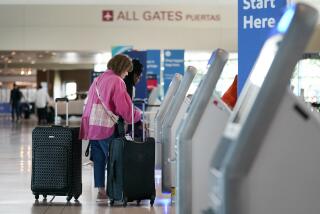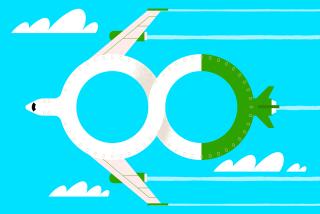Complex Air Fare Codes Catch Fliers in the Web
I once spent a night at the airport in Columbus, Ohio. It was 1986, I was fresh out of college, making very little money, and cheap air fares were still a fairly new phenomenon. I couldn’t resist the offer of a free flight voucher in exchange for giving up my seat on the last flight to New York that evening.
It was a bad move. I spent a miserable night at the airport, and I never was able to use my voucher, which had numerous restrictions. The airline went out of business before a year was up.
Fast forward 14 years to another travel experience that I went into willingly, with equally disappointing results.
After several weeks of watching air fares, my husband, Andy, and I saw that United had lowered its Thanksgiving rates to meet the competition. Because we are not frequent fliers, we try to stick with United to build up our miles. We decided to book our flight from Los Angeles to Newark, N.J., quickly to ensure our seats.
I had several options in booking the trip. I could save a little money (less than $25 for both, once the commission was paid) by booking through the corporate travel department at work.
I could book directly on United’s Internet site, https://www.united.com, which was offering 1,000 bonus miles for tickets ordered there.
Or I could book online through Expedia.com. Expedia was promising 30% off a later, second United booking.
The Expedia incentive sounded the most attractive. I read the list of restrictions carefully: Our tickets for the second trip had to be purchased by the end of December, and travel had to be completed by the end of February. There were a few blackout dates at the end of the year and a minimum ticket price of $150.
An alphabet soup of qualifying booking class codes was listed, but only one code was excluded from the promotion: code W. I didn’t know exactly what that meant, and the codes were not explained.
The route I had my eye on was Los Angeles to New Orleans for mid-January. United’s own site seemed to indicate plenty of Y-code coach seats for $209 round trip. It appeared to me that Y was the standard advance purchase coach fare (though I learned later that was not the case). With the Expedia discount, I figured I’d score air fare for two to the Big Easy for less than $300. So I booked trip No. 1 to Newark through Expedia in hopes of saving some money on trip No. 2 to New Orleans.
As it turned out, fare codes are Talmudic in their complexity; even travel agents can have a hard time sorting them out. They are basically an alphanumeric tag used by airlines in their “revenue management” system to wring the most profit out of their flights. Booking classes such as United’s W (generally, a code for the lowest-cost promotional fares) and Y (which can be used as a designation for a full-fare, nonrestricted coach ticket or as a catchall grouping for coach class on United’s own consumer Web site) are usually the first letter of a series of letters and numbers that make up an entire fare code. The rest of the coding can show such things as how far in advance a ticket was bought and whether the ticket holder is an adult, senior citizen or child. This coding is not typically revealed ahead of time to consumers who are using the Internet to book travel, but it can be accessed by travel agents or by the airlines on their own systems. And one more thing: Each airline uses different letters.
Unlike a movie, where the price of your ticket probably is the same as that of the person sitting next to you, an airplane is full of varying fares depending on how early they were purchased, how flexible the flier could be, and even where the ticket was purchased. (It costs airlines less to sell you a ticket online, so they may pass some of the savings on to you.) Usually the lowest price is for coach-class tickets bought at least several weeks in advance with the understanding that itinerary changes will incur additional charges.
The paper tickets for our trip to Newark arrived within a week, and my promotional credit was immediately deposited into my Expedia account. (That is, a link showed up under the “my rewards” section of my password-protected Expedia profile that would walk me through booking my “bonus” flight.)
After returning from Newark, I was ready to book the trip to New Orleans. I logged on to my Expedia account late one night and followed the directions. United had one nonstop flight on the days I wanted to travel. I selected the outbound flight, then the return flight. Three times, I got an on-screen message saying that the trip I requested was not eligible for the discount.
I called Expedia’s customer service number. The suggestion from the representative: “Try back later. This is the time we do our system update.”
I tried again the next morning and had the same problem. I tried two alternate return flights with stopovers; no dice. One resulted in the same message. The other choice returned a fare that was eligible but was twice the price of the lowest coach fare.
I called Expedia again. Another representative tried going through the booking process herself and said she didn’t know why it wasn’t working. She took my phone number.
A couple of hours later, another agent called to tell me that the best fare she could get me was the $209 round-trip that United had been offering all along. Did I want to book it? Thanks, but no thanks, I said.
I called United whose agent said I needed to deal with Expedia. So I called Expedia again and after 45 minutes, much of it on hold, I still could not book. There was no explanation beyond the “not eligible” line.
I gave up and booked the $209 fare through the United Web site.
So what happened, and what can you do in a similar situation?
Here was the problem: The $209 fare that had appeared to be a Y fare to me on United’s Web site was actually a promotional “deeply discounted” fare--an ineligible W fare, as I eventually found out through United’s public relations department.
Unfortunately, it may not be possible to know ahead of time whether you can apply a promotional discount to a particular fare on a particular day. Expedia, United and other travel companies with an online presence say they divulge every detail to consumers up front. Travelocity, for example, runs similar promotions with similar restrictions on its site from time to time. But no site appears to offer an explanation of these codes.
“This is a fairly unusual situation,” says Expedia marketing director Suzi LeVine. She says that though Expedia’s legal team “scours the conditions we put on our site,” the company is always looking to clarify its promotions.
LeVine acknowledges that the airline’s codes are confusing, a notion with which I concur.
I asked United why it doesn’t list all the available codes and attendant explanations on its Web site. “The consumer doesn’t know what the codes mean,” said Rebecca Zangara, manager of Internet revenue management for United. Instead, United uses Y as a “catchall” code for coach class. The Y class was allowed in the promotion, but what I had thought was a Y fare really wasn’t. I could not have known otherwise from the information available to me on the Internet.
Zangara acknowledges there is “still a lot to be done” in terms of consumer ease-of-use on airline sites. At the moment, United and others tend to focus on simplicity rather than loading people up with complex tools and information that can create confusion.
If you’re wondering what a fare class means or what the code is for a particular flight, you can try calling the airline’s own reservations line. Zangara says that airline employees would not be able to answer questions about another company’s promotion, such as Expedia’s, but they should be able to tell you the fare class for flights on United’s Web site. She emphasizes, though, that these codes are “dynamic”: that is, they can change day to day based on supply and demand. So, hypothetically, what is being sold as a W ticket today may not be available a week from now, when the plane is filling up and the only coach seats left are designated Y.
Be aware that there’s no free lunch on the Internet (or anywhere else) and that there’s really no such thing as a discount on a “deeply discounted” fare.
“The airlines usually aren’t going to give you another 30% off a fare that is already deeply discounted,” says Pat Funk, vice president of operations for the Assn. of Retail Travel Agents, a trade group based in Lexington, Ky.
Travelers bought an estimated $8 billion-plus worth of airline tickets online in 2000. But booking your best deal isn’t always as easy as a few clicks of the mouse. “The numbers show that buying online is growing--but I’m also hearing from people who say clients came back to them in frustration after trying the Web,” Funk says. Among the common complaints: Booking procedures and rules are confusing or misleading.
“[The travel Web sites] are counting on the average consumer to book with them, without really knowing what the deal is,” Funk says.
You may not get the full story on a Web site, and the Web isn’t always the best source of low fares. The October issue of Consumer Reports Travel Letter found that “the Internet is an exciting new tool, but it’s no more likely to garner you the best air fare than a low-tech telephone” call to an agent or airline.
As for me, I didn’t lose much in this experience--just a couple of hours of my life and the opportunity to save some money or gain 1,000 frequent flier miles. I know that $209 is still a good fare from Los Angeles to New Orleans. I’ll continue using the Internet to research and book travel. But I probably won’t choose a site solely on the promise of a future discount. Never let it be said I’m a slow study.
*
Times Travel Writer Christopher Reynolds is on vacation. Marla Matzer Rose is a Los Angeles-based journalist and author.
More to Read
Sign up for The Wild
We’ll help you find the best places to hike, bike and run, as well as the perfect silent spots for meditation and yoga.
You may occasionally receive promotional content from the Los Angeles Times.






